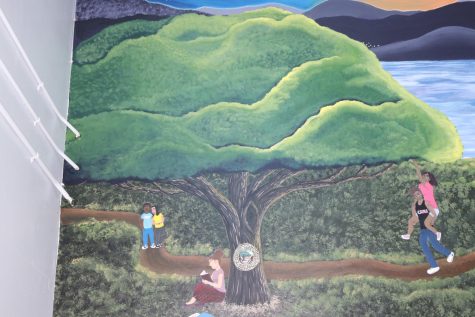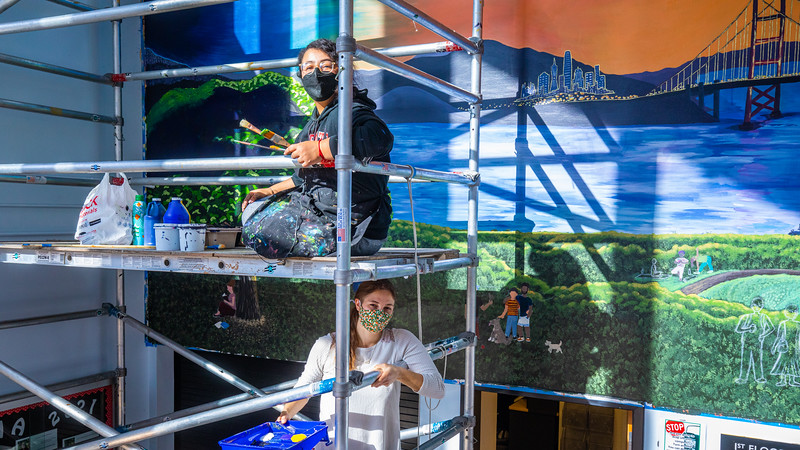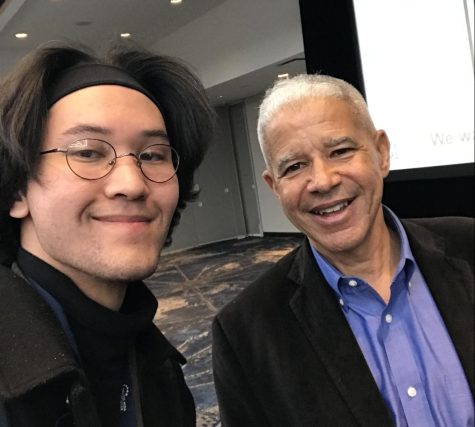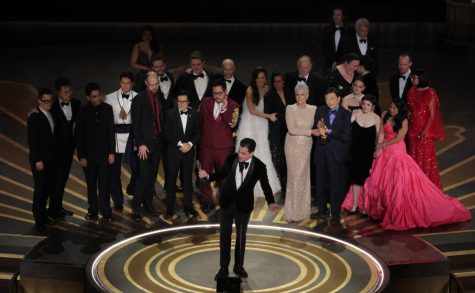Painting The Campus With Culture
CSUEB alumna, Josefina Rocha Vega, (top) and faculty member, Dr. Amara Miller, (below) finishing up the mural.
February 23, 2022
New Student-Made Mural That Promotes Diversity and Inclusion Unveiled On Campus
On Feb. 5, current California State University, East Bay students, and alumni completed a mural in the lobby of El Dorado Hall, a student residential building on campus. The mural represents and promotes diversity and inclusion on the California State University East Bay campus.
The idea behind and creation of the mural is a collaboration between the student artists and the Diversity Advisory Committee (DAC). DAC is a community-dedicated group at CSUEB that addresses inequalities and prioritizes inclusion and diversity on campus.
One of the main artists that worked on the mural is a recent graduate from CSUEB’s Art Department, Josefina Rocha Vega. She spoke on her experience with painting the mural and how the ideas for the mural came to fruition.
“We’ve taken some of their [DAC’s] initial thoughts and ideas for the mural and involved that with our people and the East Bay community,” said Vega.
Vega pointed out the meaning behind specific aspects of the mural. One example is the stars which symbolize CSUEB’s motto, “Per Aspera Ad Astra,” which translates to “Through Adversity to the Stars.”
Another detail Vega pointed out was the tree she painted as a part of the mural and how it proudly symbolizes representing your identity as a student.
“The tree is a representation of standing our ground as students and initiating that growth for the future within us through being at East Bay,” Vega explained.

Diversity and inclusion are always important, but it is especially crucial to uphold those standards on a campus like CSUEB. It is a university that prides itself and is recognized as one of the nation’s most diverse public universities.
Representation in art is important, and making that art accessible to everyone is one thing a diverse community like CSUEB should be prioritizing. Vega talks more about how that representation and accessibility inspired the mural.
“Using the arts at East Bay helps elevate what students and faculty want to see on a wall, through diversity of people. It has taken a long time, but it’s worth it when someone looks at the mural, and they’re like, wow, I see myself, this is what East Bay is to me, it’s a home to people; they see themselves in it,” said Vega.
The message behind the mural is significant, and it is also a large piece of art on a physical scale. The mural’s large size is one of the main reasons El Dorado was chosen to be the home, giving the artists plenty of canvas space to paint on. Another reason is the high foot traffic that El Dorado gets daily.
“When I was painting, a lot of people have seen it and showed excitement and were in awe of the mural,” mentioned Vega.
For a campus with a decent-sized art department, you would think there would be a bit more art around campus. Displaying art on campus can have inspiring effects on onlookers; there is always a need for more public art.
“I feel like there can be so much more art and representation on walls, not just paintings, but it could also be poetry…Maybe you’re walking on campus one day, and you pass by a wall, and then you’re like, wow, that really speaks to me,” explained Vega.
Art’s effect on people can truly drive them to take action and feel more inspired in general, especially when they feel seen and represented within that art.
While CSUEB is known for being an inclusive and diverse campus, there is always room for improvement. Josefina shares her experience in the art department in particular.
“I feel that I didn’t really lack any inclusivity with the art department and the school. I was very welcomed, I was told not to be afraid to express myself, and it could be different for other departments, don’t get me wrong, but, in the art department, I’m so thankful to know faculty who are not afraid to speak out on certain topics and encourage students to express themselves through their art,” said Vega.
She does acknowledge that there could always be more open minds, which is one thing she and the other artists hope to achieve with the mural.
Josefina and the other artists began painting the mural on Jan. 4, but it has been a three-year-long process from the idea to the actual completion. It would not have been possible without the help of many people.
Vega gives a shoutout and huge thanks to the Office of Communications and Marketing, who provided the funding for the mural. Because of that funding, Vega says they were able to get scaffolding and were able to pay the artists for their time and work.
“We were able to move forward with this vision. I am super grateful to be involved, and honestly, I’m really hoping there could be more celebrations of diversity like this on campus. More murals, more events, that allow faculty to collaborate with students in order to express themselves and to address certain topics that are necessary to have conversations about,” discussed Vega.
Dr. Ryan Gamba, a professor in the Department of Public Health, also deserves a shoutout for his contributions behind the scenes and support for the movement to get the mural on the wall.
All of the main artists of the mural are women of color; Vega is one of them. Cynthia Syriani was another main artist, Isabelle Ortiz, and Betelhem Weldegebriel, who helped with the leg work and got the mural up on the wall. Amara Miller, a professor in the Department of Sociology, also helped with the mural painting.
The mural is officially complete now and can be viewed in the lobby of El Dorado; check it for yourself!

















